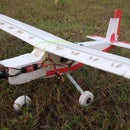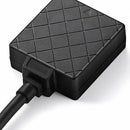Introduction: Universal IR Remote Using Arduino Nano
It becomes tedious when multiple remotes of different or same appliance lie around and you have to find each one when needed like AC, TV, Music players. to overcome this problem we will make an arduino nano based universal remote which can act as all in one remote.
to make this universal remote you will require:
Supplies
Arduino Nano: https://www.flyrobo.in/arduino_nano_r3_board_with_ch340_chip?tracking=ins
TSOP1738:https://www.flyrobo.in/ir-receiver-tsop1738-infrared-receiver-sensor?tracking=ins
IR LED: https://www.flyrobo.in/ky-005-infrared-ir-transmitter-sensor-module?tracking=ins
Push button:
https://www.flyrobo.in/2-pin-tactile-switch?tracking=ins
https://www.flyrobo.in/button-tactile-switch-spst?tracking=ins
Resistors: https://www.flyrobo.in/resistors-electronic-components?tracking=ins
RGB LED: https://www.flyrobo.in/ky-016_rgb_3_color_led_module?tracking=ins
circuit board: https://www.flyrobo.in/electronics-pcb-and-boards?tracking=ins
Step 1: Working Principle
This project basically works in two parts
part 1: decoding signals
IR remotes basically transmit Infrared light bursts in particular patterns so that each signal can be distinguished.
the burst contains fast on and off signals which carry the signal up to several kilohertz. In this part we will decode those signals using a receiver IR LED TSOP1738 or any kind of IR receiver.
part 2: Using decoded values for remote
once the signal is decoded and converted to binary, the code is modified and uploaded to Arduino nano.
configuration of switches according to their functions can also be done.
Step 2: Decoding the Signals
To decode the signals to binary, Arduino is wired according to the above-shown image. The code for this process is given below. upload the code to Arduino for decoding signals.
press keys of remote one by one which is going to be included in our remote in front of the IR receiver, while keeping the serial monitor open. after pressing one key on the remote you will observe some numerical values note that down to the corresponding button on the remote. after making list for different remotes and their signals, disconnect the Arduino and all other wirings.
Attachments
Step 3: Setting Up the Main Circuit
- Firstly wire up the circuit according to this new diagram. we have used here prototyping board, however you can design your own PCB.
- Now starting from code, take out the list of decoded signals and write in to the designated place in the code according to the remote type.
- Once done check for the transmitted signal by testing in front of that appliance by watching its response.
- For powering up the remote 9v battery is used. Li-ion rechargeable batteries can also be used. also 3D printed case for the circuits can be made so that it looks professional.
Attachments
Step 4: Conclusion
With this project, you can improve Arduino coding knowledge, and if you set up this device in the proper box and cover then you can use it in everyday applications.
The best thing about this project is you can control every appliance which supports IR you just need to record the IR signal from the original remote and implement it in the code.
In today's world where almost all devices are working remotely even People are using BLDC fans at home and they support IR remote, So this project is very useful.














